Romanee Saint-Vivant is somehow the rising star among the Grand cru’s of Vosne Romanee. For many years Richebourg was undisputed number four after the three big Grand Cru’s – Romanee-Conti, La Romanee and La Tache. But in the last two decades the wines from Romanee Saint-Vivant have shown big improvements, and the vineyard is now a worthy rival to Richebourg – and sometimes even surpassing it’s more masculine neighbour.
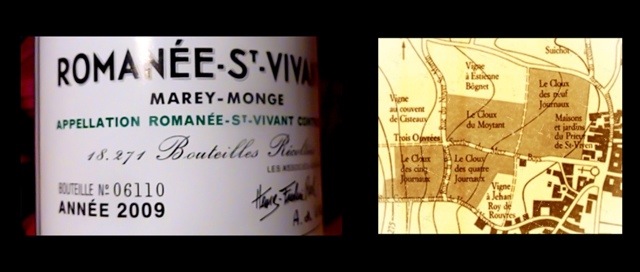
Early history of Romanee-Saint-Vivant
The history of Romanee Saint-Vivant dates back to the 11th century, when Hugues II (1085-1143), Duke of Burgundy gave all his uncultivated areas and forests in Vosne and Flagey to the monks of the abbey of Saint-Vivant which was a Priory under the great Priory of Cluny. This took place on November 13th 1131, and the monks then started to clear the uncultivated areas and began planting vines. In 1232, Alix de Vergy, wife of the Eudes II (also Duke of Burgundy), began to donate some additional vineyards to the monks of the Priory of Saint-Vivant – 5 donations were made in the period from 1232 to 12467.
These donations included the vineyards Cloux du Neuf Journaux (3.06 ha), Cloux du Moytans (1.70 ha), Cloux des Quatre Journaux (1.36 ha) – in total a little more than 6 ha of the current Romanee Saint-Vivant. The donation also included a vineyard called le Cloux des Cinq Journaux (the current Romanée-Conti) The word “journaux” in the original plot names refers to the size of the vineyard, one journaux is approximately 34 ares equivlent to 0.34 ha.
The name Romanee-Saint-Vivant was first used in 1765, and at that time it only comprised the “original” 6 ha (dix-huit journaux) of the vineyard – the last plots – in total 3.4 ha – were added later – see below.
On September 11th, 1936 the climate gets AOC Grand Cru status for the full area today know as Romanne-Saint-Vivant.
The two missing sections
It’s not totally clear when the last two sections – Vigne a Estienne Bognet and Vigne a Jehan Roy du Rouvres were added to Romanee Saint-Vivant.
The two sections were already included in 1827 where the first cadastre maps were made. The map below show that Romanee Saint-Vivant in 1827 covered approximately the same area as today – with one minor exception – see more details in the paragraphs below.
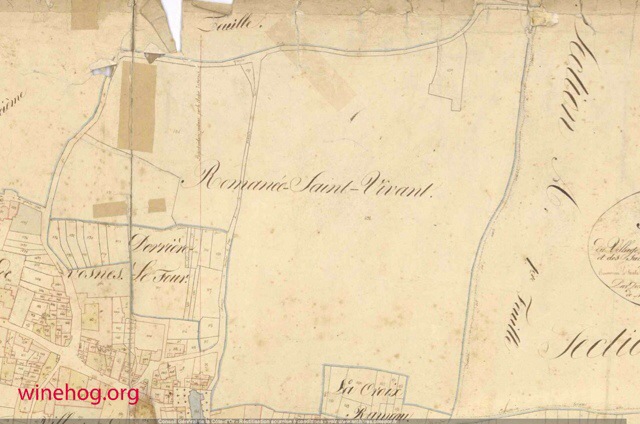
This is confirmed by Lavalle1 in 1855, where the total area of Romanee Saint-Vivant was 9 ha and 54 ares – this is very comparable to the current area of 9 ha and 43 ares.
The “Vigne a Jehan Roy du Rouvres” section
The early history of this section is not very clear, but in 1774 it’s was according to Bazin7 owned by Karl-Josef Riepp a organ builder and negociant from Dijon. In the nineteenth century it was owned by the Jondot family – Lavalle mention this in 1855 – and Bazin mention Jondot-Maignot 7. Later it was sold to the Moilliard family (Thomas-Moillard/Moillard-Grivot) – and this family kept the plot until 1984, when Prof. Andre Galtié – a nephew of Charles Thomas – died and the plot was divided and sold – see more info about the Thomas-Moillard section below.
It’s important to note – this section has never been owned by the church and was never included in the Marey-Monge holdings in Romanee-Saint-Vivant. This is supported by the cadastre maps from 1827, where this part is a separate plot.
The “Vigne a Estienne Bognet” section
This section in the northwest part of Romanee Saint-Vivant was according to Bazin7 included in the Clos du Moytan plot by plot by the Marey-Monge family. From 1791 to 1807 fourteen small plots were acquired, and the last plot of 2,5 oeuvres was acquired in 1821.
The cadastre maps from 1827 show that there is still a single plot outside the big Marey-Monge holdings in the northwest part of Romanee Saint-Vivant – this plot is shown on the map below.
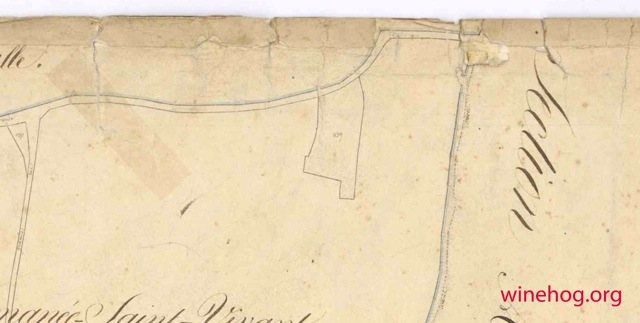
This could indicate that Marey-Monge acquired the plot just before the cadastre maps were made, or that they in fact acquired this plot later than 1821.
The border towards La Croix Rameau
There have been a lot of discussions about whether La Croix Rameau, or at least part of it, once were included in the vineyard know as Romanee Saint-Vivant.
I’m currently exploring this, but it’s clear that if this was the case – it was before 1827 – as the cadastre map below show that La Croix Rameau was established when the first cadastre maps were made.
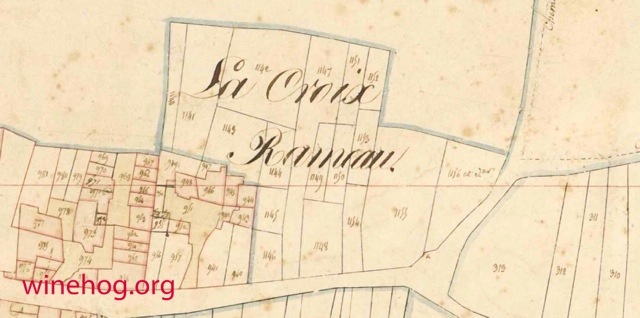
There is however a small but interesting detail – the plot no 1152 located in the upper part of La Croix Rameau (under the “x” in Croix), it seems to have been included in Romanee Saint-Vivant after 1827. This plot was either acquired by Marey-Monge and included in Romanee Saint-Vivant – or perhaps Marey-Monge owned a part of La Croix Rameau, and included a part of these holdings in Romanee Saint-Vivant after 1827.
The Marey-Monge ownership
Romanee Saint-Vivant and the other holdings of the Priory of Saint Vivant was seized under the French revolution and was sold in 1791 to Nicolas-Joseph Marey, the son-in-law of Gaspard Monge. The Marey-Monge family bought some of the Priorys buildings in Vosne Romanee and most of the vineyards.
As mentioned above the Marey-Monge family continued to expand the holdings in Romanee Saint-Vivant, thus enlarging the three original sections – Clos du Neuf Journaux, Clos du Moytans and Clos des Quatre Journaux.
But did Marey-Monge at any time obtain monopoly ownership of Romanee Saint-Vivant? The answer is most likely no, as the Vigne a Jehan Roy du Rouvres section never seem to have been under Marey-Monge ownership, and this section was included in Romanee Saint-Vivant before 1827 according to the cadastre maps.
The main part of Romanee-Saint-Vivant was however under Marey-Monge ownership for almost 70 years, where the first section was sold off. In 1898 the Marey family sold the section Clos de quatre Journaux to Louis Latour.
It is however likely that the first plots were sold off even earlier, as the Gaudemet-Chanut have produced Romanee-Saint-Vivant in vintages before 1900. The Gaudemet family have seen bottles of 1890 Romanee-Saint-Vivant from the family domaine, and 1899 RSV is documented with a label. Gaudemet is not mentioned as a owner by Danguy and Aubertin in 1890, but Rodier mention Gaudemet in 1920 as one of the owners. The Gaudemet plot was sold of to Charles Noellat in 1925 after Marguerite Gaudemet passed away. The Noellat plot was originally 1,97 ha and is located in northern part of the vineyard next to the road between Romanee Saint Vivant and Les Suchots. The Gaudemet plot on Romanee-Saint-Vivant was never a part of the Chanut estate, but was acquired by Paul Gaudemet and his wife Marguerite Gaudemet (born Chanut) – most likely around 1890.
In 1966 the remaining part of Romanee Saint-Vivant (5.28 ha) was leased to Domaine-de-la-Romanee Conti by Geneviève Marey-Monge, with a clause stating that DRC had a option to buy the vineyard if it came up for sale. The Neyrand family, decendents of the Marey-Monge family, finally sold the rest of Romanee Saint-Vivant to Domine-de-la-Romanee-Conti in 1988.
The map below show the four main sections in the Romanee Saint-Vivant vineyard.
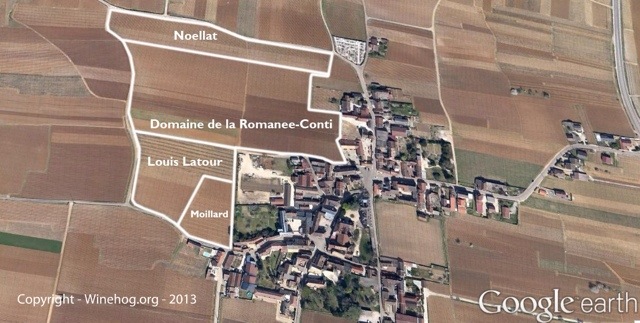
Clos des Quatre Journaux – The Louis Latour section
This original section was bought by Louis Latour in 1898 just four years before his death. After his death the section was divided almost equally between his son Louis Latour and his daughter Marie Poisot. Louis Latour got the northern part of Clos des Quatre Journaux – the current Louis Latour plot, and Marie Poisot got the southern part towards La Grand Rue – the Poisot part was in total around 0.75 ha, while the Latour part is repported to be slightly bigger – 0.80 ha.
The Poisot part of Clos des Quatre Journaux has since been divided in to three plots, but the two plots in the southwest corner just below Romanee-Conti are still owned by the Poisot family. Domaine l’Arlot acquired a 0.25 ha plot from Henri Poisot-Piquet in 1990 – a plot located between the current Poisot plot and the Louis Latour plot – also just below Romanee-Conti.
The Southeast corner – The Thomas-Moillard section
East of the Poisot plots – just above the garden of Gros Frere et Soeures – we now find three additional plots in the Thomas-Moillard section (Vigne a Jehan Roy du Rouvres).
It’s as mentioned above unclear when Thomas-Moillard acquired this section of the Romanee Saint-Vivant vineyard. Some sources say Cathiard began making wine from Romanee-Saint-Vivant in 1940s, on the vineyards owned by Thomas-Moillard, and Robert Arnoux/Arnoux-Lachaux have made wines since the late 1920s on this plot – so most likely the Thomas-Moillard ownership dates back to the start of the twentieth century.
Robert Arnoux Lachaux has a 0.35 ha plot which was acquired from the Thomas-Moillard family in 1984. Arnoux began making Romanee-Saint-Vivant from this plot in the late 1920s, but the plot remained under Moillard ownership until 1984.
The two remaining plots in the southeast corner are now owned by Domaine Sylvain Cathiard and Wilfred Jaeger (Dujac). These plots are 0,17 ha each and were also a part of the Thomas-Moillard estate. Cathiard bought his plot in 1984, while the Dujac plot was acquired in 2004, when the Thomas-Moillard estate was sold and divided.
The current ownership of Clos des Quatre Journaux and the Moillard section
The map below show the owners allocated to the specific plots on Clos des Quatre Journaux and the southeast section of the Romanee-Saint-Vivant the vineyard.
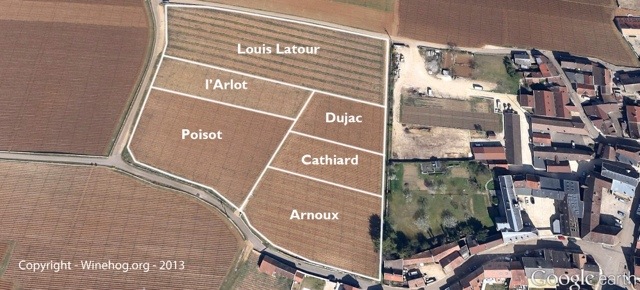
The current owners on the Clos des Quatre Journaux and the Thomas-Moillard sections are summarized below:
- Louis Latour – 0,80 ha
- The Poisot Family – 0.50 ha
- Robert Arnoux – 0,35 ha
- de l’Arlot (owned by Axa) – 0.25 ha
- Sylvain Cathiard – 0,17 ha
- Domaine Dujac (Owned by Wilfred Jaeger) – 0,17 ha
The Northern part of Romanee Saint-Vivant – the Gaudemet & Charles Noellat section
The Marey-Monge family sold this 1,97 ha sextion to Gaudemet-Chanut around 1890. After the death of Marguerite Gaudemet in 1925 the Gaudemet-Chanut domaine was sold to Charles Noellat – including the plot on Romanee-Saint-Vivant. The section was keept in the Noellat family for many years but devided between the heirs of Charles Noellat.
You need to login as a Premium subscriber to read the rest of this article. If you are not a Premium Subscriber, use the subscribe function and sign-up.

 - A true vin d’émotion – a Burgundy of passion
- A true vin d’émotion – a Burgundy of passion - A truly hedonistic wine – lively and enjoyable
- A truly hedonistic wine – lively and enjoyable - A vivacious wine for pure indulgance
- A vivacious wine for pure indulgance - A potential vin d´émotion - frais et léger
- A potential vin d´émotion - frais et léger